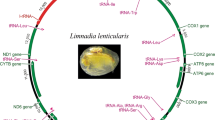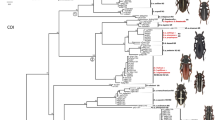Abstract
Systematics and evolution of Malagasy lemurs has been analyzed using morphological characters, fossil evidence, ecological/ethological data, and chromosomal banding patterns. Recent developments in DNA technology have provided evolutionary biologists with additional and powerful tools for making phylogenetic inference. In the last years several studies concerning highly repeated DNA sequences (hrDNA) provided new insights about the systematic relationships among the different species of Lemuridae and Cheirogaleidae.
Here, a reconstruction of molecular phylogeny of extant Malagasy lemurs based on the comparison of cytochrome-b mitochondrial DNA sequences is presented. With the Polymerase Chain Reaction (PCR) and direct sequencing of amplified DNA fragments, both the phylogenetic range and resolving power of comparative analysis can be extended. These techniques allow to gather sequence data useful to evaluate the pattern of molecular evolution offering opportunities for phylogenetic purposes.
A 290-bp fragment of cytochrome-b gene has been amplified and sequenced from the following species:Tupaia glis, Galago alleni, Daubentonia madagascariensis, Indri indri, Varecia variegata, Eulemur fulvus, Eulemur coronatus, Eulemur rubriventer, Eulemur mongoz, Eulemur macaco, Lemur catta, andHapalemur griseus griseus.
The phylogenetic trees obtained show the relationships among the Eulemur species and confirm the karyological and hrDNA results of a separated clade forL. catta/Hapalemur. The separation ofVarecia variegata from the other genus of the family Lemuridae is discussed.
Similar content being viewed by others
References
Affolter, M., 1938. Les organes cutanés brachiaux d’Hapalemur griseus.Bull. Acad. Malgache, 8(20): 77–100.
Anderson, S., A. T. Bankier, B. G. Barrell, M. H. L. de Bruijn, A. R. Coulson, J. Drouin, C. Eperon, D. P. Nierlich, B. A. Roe, F. Sanger, P. H. Schreier, A. J. H. Smit, R. Staden, &I. G. Young, 1981. Sequence and organization of the human mitochondrial genome.Nature, 290: 457–464.
Andrew, R. J., 1964. The displays of the primates. In:Evolutionary and Genetic Biology of Primates, Vol. 2,J. Buettner-Januch (ed.), Academic Press, New York, pp. 227–309.
Brown, W. M., E. M. Prager, A. Wang, &A. C. Wilson, 1982. Mitochondrial DNA sequences of primates: tempo and mode of evolution.J. Mol. Evol., 18: 225–239.
Crovella, S., D. Montagnon, B. Rakotosamimanana, &Y. Rumpler, 1994. Molecular biology and systematics of an extinct lemur:Pachylemur insignis.Primates, 35: 519–522.
————, &Y. Rumpler, 1993. Highly repeated DNA analysis and systematics of the Lemuridae, a family of Malagasy prosimians.Primates, 34: 61–69.
———— &Y. Rumpler, 1992. Confirmation of the specific status ofHapalemur aureus (Primates, Strepsirhini) by restriction genomic DNA banding patterns.Human Evol., 7: 63–67.
Disotell, T. R., R. L. Honeycut, &M. Ruvolo, 1992. Mitochondrial DNA phylogeny of the Old-world monkey tribe Papionini.Mol. Biol. Evol., 9: 1–13.
Duffy, L. K. & D. H. Coppenhaver, 1986. Molecular evolution of prosimians hemoglobins.Ann. New York Acad. Sci., 254–257.
Dunaif, A. &I. Tattersall, 1991. Lemur species show differences in immunological and biological activity of luteinizing hormone.Folia Primatol., 57: 173–176.
Eaglen, R. H., 1983. Parallelism, parsimony and the phylogeny of Lemuridae.Int. J. Primatol., 4: 249–273.
Feagle, J., 1988.Primate Adaptation and Evolution. Academic Press, New York.
Felsenstein, J., 1981. Evolutionary trees from DNA sequences: a maximum likelihood approach.J. Mol. Evol., 17: 368–376.
————, 1993. PHYLIP (Phylogeny Inference Package), Version 3.5c, Dept. of Genetics, Univ. of Washington, Seattle, Washington.
Garza, C. J. &D. S. Woodruff, 1992. A phylogenetic study of the gibbons (Hylobates) using DNA obtained non invasively from hairs.Mol. Phyl. Evol., 1: 202–210.
Gray, J. E., 1863. Cited byW. C. O. Hill (1953).Primates: Comparative Anatomy and Taxonomy. III-IV: Lemuroidea-Strepsirhini. Edinburgh Univ. Press, Edinburgh.
Groves, C. P., 1989.A Theory of Human and Primate Evolution. Clarendon Press, Oxford.
———— &R. H. Eaglen, 1988. Systematics of the Lemuridae (Primates, Strepsirhini).J. Human Evol., 17: 513–538.
Hayasaka, K., T. Gojobori, &S. Horai, 1988. Molecular phylogeny and evolution of primate mitochondrial DNA.Mol. Biol. Evol., 5: 626–644.
Hill, W. C. O., 1953.Primates: Comparative Anatomy and Taxonomy. I: Strepsirhini. Edinburgh Univ. Press, Edinburgh.
Hixon, J. E. &W. M. Brown, 1986. A comparison of the small ribosomal RNA gene from the mitochondrial DNA of the great apes and humans: sequence, structure, evolution and phylogenetic implications.Mol. Biol. Evol., 3: 1–18.
Jung, K. Y. S., S. Crovella, &Y. Rumpler, 1992. Phylogenetic relationships among Lemuriform species determined from restriction genomic DNA banding patterns.Folia Primatol., 58: 224–229.
Kimura, M., 1980. A simple model for estimating evolutionary rates of base substitutions through comparative studies of nucleotide sequences.J. Mol. Evol., 16: 111–120.
Kocher, T. D., W. K. Thomas, A. Meyer, S. V. Edwards, S. Pääbo, F. X. Villablanca, &A. C. Wilson, 1989. Dynamics of mitochondrial DNA evolution in animals: amplification and sequencing with conserved primers.Proc. Natl. Acad. Sci. U.S.A., 86: 6196–6200.
Maddison, W. P. &D. R. Maddison, 1992. MacClade: Analysis of Phylogeny and Character Evolution, Version 3.04, Sinauer Associates, Inc., Sunderland, Massachusetts.
Montagnon, D., S. Crovella, &Y. Rumpler, 1993. Comparison of highly repeated DNA sequences in some Lemuridae and taxonomic implications.Cytogenet. Cell Genet., 63: 131–134.
Napier, J. R. &P. H. Napier, 1967.A Handbook of Living Primates. Academic Press, New York.
Pääbo, S., R. Higuchi, &A. C. Wilson, 1989. Ancient DNA and the polymerase chain reaction.J. Biol. Chem., 264: 9709–9712.
Petter, J. J., 1962. Recherches sur l’ecologie et l’éthologie des lémuriens malagaches.Mém. Mus. Natl. Hist. Nat. Paris, 27: 1–146.
————,R. Albignac, &Y. Rumpler, 1977. Mammifères lémuriens (Primates, Prosimiens). In:Fauna de Madagascar, No. 44, O.R.S.T.O.M.-C.N.R.S., Paris.
Pocock, R. I., 1918. On the external characters of the lemurs and ofTarsius.Proc. Zool. Soc., 55: 19–53.
Rumpler, Y., 1975. The significance of chromosomal studies in the systematics of the Malagasy lemurs. In:Lemur Biology,I. Tattersall &R. W. Sussmann (eds.), Plenum Press, New York, pp. 25–40.
———— &A. Andriamiandra, 1968. Sur l’étude des glande brachiales et antébrachiales duLemur catta.C. R. Soc. Biol., 162: 1430–1433.
———— &B. Dutrillaux, 1978. Chromosomal evolution in Malagasy lemurs. III: Chromosome banding studies in the genusHapalemur and the speciesLemur catta.Cytogenet. Cell Genet., 21: 201–211.
———— & ————, 1986. Evolution chromosomique des prosimiens.Mammalia, 50: 82–107.
Ruvolo, M., T. R. Disotell, M. W. Allard, W. M. Brown, &R. L. Honeycutt, 1991. Resolution of the african hominoid tricotomy by use of a mitochondrial gene sequence.Proc. Natl. Acad. Sci. U.S.A., 88: 1570–1574.
Saitou, N., 1991. Reconstruction of molecular phylogeny of extant hominoids from DNA sequence data.Amer. J. Phys. Anthropol., 84: 75–85.
———— &M. Nei, 1987. The neighbor-joining method: a new method for reconstructing phylogenetic trees.Mol. Biol. Evol., 4: 406–425.
Sambrook, J., E. F. Fritsch, &T. Maniatis, 1989.Molecular Cloning: A Laboratory Manual (2nd ed.), Cold Spring Harbor Laboratory Press, New York.
Sanger, F., S. Nicklen, &A. R. Coulson, 1977. DNA sequencing with chain termination inhibitors.Proc. Natl. Acad. Sci. U.S.A., 74: 5463–5467.
Shedd, D. H. &J. M. Macedonia, 1991. Metachromism and its phylogenetic implications for the genusEulemur.Folia Primatol., 57: 221–231.
Simons, E., 1972.Primate Evolution. Macmillan, New York.
———— &Y. Rumpler, 1988.Eulemur: new generic name of species ofLemur other thanLemur catta.C. R. Acad. Sci. Paris, 307 (Serie III): 547–551.
Swofford, D. L., 1990. PAUP (Phylogenetic Analysis Using Parsimony), Version 3.0, Illinois, Natural History Survey, Champaign, Illinois.
Szalay, F. &E. Delson, 1979.Evolutionary History of the Primates. Academic Press, New York.
Tattersall, I., 1983.The Primates of Madagascar. Columbia Univ. Press, New York.
Wilson, A. C., R. L. Cann, S. M. Carr, M. George, U. B. Gyllensten, K. M. Helm-Bychowski, R. G. Higuchi, S. R. Palumbi, E. M. Prager, R. D. Sage, &M. Stoneking, 1985. Mitochondrial DNA and two perspectives on evolutionary genetics.Biol. J. Linn. Soc., 26: 375–400.
Yoeder, A. D., 1994. Relative position of the Cheirogaleidae in Strepsirhini phylogeny: a comparison of morphological and molecular methods results.Amer. J. Phys. Anthropol., 94: 25–46.
Author information
Authors and Affiliations
About this article
Cite this article
Del Pero, M., Crovella, S., Cervella, P. et al. Phylogenetic relationships among Malagasy lemurs as revealed by mitochondrial DNA sequence analysis. Primates 36, 431–440 (1995). https://doi.org/10.1007/BF02382865
Received:
Accepted:
Issue Date:
DOI: https://doi.org/10.1007/BF02382865




